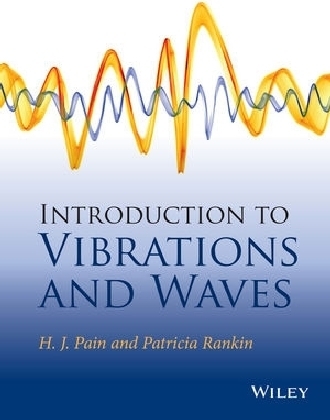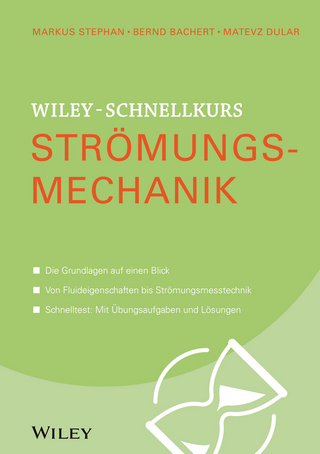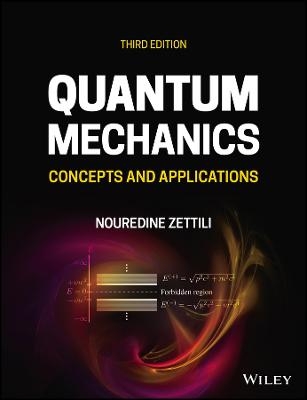
Introduction to Vibrations and Waves
John Wiley & Sons Inc (Verlag)
978-1-118-44110-7 (ISBN)
Based on the successful multi-edition book “The Physics of Vibrations and Waves” by John Pain, the authors carry over the simplicity and logic of the approach taken in the original first edition with its focus on the patterns underlying and connecting so many aspects of physical behavior, whilst bringing the subject up-to-date so it is relevant to teaching in the 21st century.
The transmission of energy by wave propagation is a key concept that has applications in almost every branch of physics with transmitting mediums essentially acting as a continuum of coupled oscillators. The characterization of these simple oscillators in terms of three parameters related to the storage, exchange, and dissipation of energy forms the basis of this book. The text moves naturally on from a discussion of basic concepts such as damped oscillations, diffraction and interference to more advanced topics such as transmission lines and attenuation, wave guides, diffusion, Fourier series, and electromagnetic waves in dielectrics and conductors. Throughout the text the emphasis on the underlying principles helps readers to develop their physics insight as an aid to problem solving.
This book provides undergraduate students of physics and engineering with the mathematical tools required for full mastery of the concepts. With worked examples presented throughout the text, as well as the Problem sets concluding each chapter, this textbook will enable students to develop their skills and measure their understanding of each topic step-by-step.
A companion website is also available, which includes solutions to chapter problems and PowerPoint slides.
Review of “The Physics of Vibrations and Waves 6e“
This is an excellent textbook, full of interesting material clearly explained and fully worthy of being studied by future contributors ..." Journal of Sound and Vibration
H. J. Pain Emeritus, Department of Physics, Imperial College London, UK Patricia Rankin Department of Physics, University of Colorado, USA
Acknowledgement x
About the companion website xi
Preface xii
Introduction xiii
Table of Constants xiv
Table of Energy Storing Processes xv
1 Simple Harmonic Motion 1
1.1 Displacement in Simple Harmonic Motion 4
1.2 Velocity and Acceleration in Simple Harmonic Motion 7
1.2.1 Non-linearity 8
1.3 Energy of a Simple Harmonic Oscillator 8
1.4 Simple Harmonic Oscillations in an Electrical System 12
1.5 Superposition of Two Simple Harmonic Vibrations in One Dimension 14
2 Damped Simple Harmonic Motion 21
2.1 Complex Numbers 22
2.2 The Exponential Series 22
2.2.1 The Exponential Series and the Law of Compound Interest 23
2.2.2 Note on the Binomial Theorem 25
2.2.3 Region 1. Heavy Damping (r2/4m2 > ω20) 28
2.2.4 Region 2. Critical Damping (r2/4m2 = ω20) 30
2.2.5 Region 3. Damped Simple Harmonic Motion (r2/4m2 < ω20) 31
2.3 Methods of Describing the Damping of an Oscillator 33
2.3.1 Logarithmic Decrement 33
2.3.2 Relaxation Time or Modulus of Decay 35
2.3.3 The Quality Factor or Q-value of a Damped Simple Harmonic Oscillator 35
2.3.4 Energy Dissipation 37
2.3.5 Damped SHM in an Electrical Circuit 38
3 The Forced Oscillator 41
3.1 The Operation of i upon a Vector 41
3.2 Vector Form of Ohm’s Law 43
3.3 The Tuned LCR Circuit 45
3.4 Power Supplied to Oscillator by the Input Voltage 47
3.5 The Q-Value in Terms of the Resonance Absorption Bandwidth 48
3.6 The Forced Mechanical Oscillator 50
3.7 Behaviour of Velocity v in Magnitude and Phase versus Driving Force Frequency ω 56
3.8 Behaviour of Displacement x versus Driving Force Frequency ω 57
3.9 The Q-Value as an Amplification Factor 59
3.10 Significance of the Two Components of the Displacement Curve 60
3.11 Problem on Vibration Insulation 63
3.12 The Effect of the Transient Term 65
4 Coupled Oscillations 69
4.1 Stiffness (or Capacitance) Coupled Oscillators 69
4.2 Normal Modes of Vibration, Normal Coordinates and Degrees of Freedom 72
4.3 Mass or Inductance Coupling 77
4.4 Coupled Oscillations of a Loaded String 81
4.5 The Wave Equation 87
5 Transverse Wave Motion (1) 95
5.1 Partial Differentiation 95
5.2 Waves 98
5.3 Velocities in Wave Motion 99
5.4 The Wave Equation 99
5.5 Solution of the Wave Equation 101
5.6 Characteristic Impedance of a String (the String as a Forced Oscillator) 105
5.7 Reflection and Transmission of Waves on a String at a Boundary 108
5.8 Reflection and Transmission of Energy 112
5.9 The Reflected and Transmitted Intensity Coefficients 113
5.10 Matching of Impedances 113
5.11 Standing Waves on a String of Fixed Length 113
5.12 Standing Wave Ratio 116
5.13 Energy in Each Normal Mode of a Vibrating String 116
6 Transverse Wave Motion (2) 121
6.1 Wave Groups, Group Velocity and Dispersion 121
6.1.1 Superposition of Two Waves of Almost Equal Frequencies 121
6.1.2 Wave Groups, Group Velocity and Dispersion 123
6.2 Wave Group of Many Components. The Bandwidth Theorem 125
6.3 Heisenberg’s Uncertainty Principle 128
6.4 Transverse Waves in Periodic Structures (1) Waves in a Crystal 129
6.5 Linear Array of Two Kinds of Atoms in an Ionic Crystal 132
6.6 Transverse Waves in Periodic Structures (2) The Diffusion Equation, Energy Loss from Wave Systems 135
7 Longitudinal Waves 141
7.1 Sound Waves in Gases 141
7.2 Energy Distribution in Sound Waves 145
7.3 Intensity of Sound Waves 148
7.4 Longitudinal Waves in a Solid 149
7.5 Application to Earthquakes 151
7.6 Reflection and Transmission of Sound Waves at Boundaries 152
7.7 Reflection and Transmission of Sound Intensity 154
7.8 Water Waves 154
7.9 Doppler Effect 156
8 Waves on Transmission Lines 161
8.1 Ideal or Lossless Transmission Line 163
8.2 Coaxial Cables 164
8.3 Characteristic Impedance of a Transmission Line 165
8.4 Reflections from the End of a Transmission Line 167
8.5 Short Circuited Transmission Line (ZL =0) 167
8.6 The Transmission Line as a Filter 169
8.7 Effect of Resistance in a Transmission Line 172
8.8 Characteristic Impedance of a Transmission Line with Resistance 176
8.9 Matching Impedances 178
9 Electromagnetic Waves 183
9.1 Maxwell’s Equations 183
9.2 Electromagnetic Waves in a Medium having Finite Permeability μ and Permittivity ε but with Conductivity σ =0 186
9.3 The Wave Equation for Electromagnetic Waves 188
9.4 Illustration of Poynting Vector 189
9.5 Impedance of a Dielectric to Electromagnetic Waves 191
9.6 Electromagnetic Waves in a Medium of Properties μ, ε and σ (where σ ≠ 0) 193
9.7 Skin Depth 196
9.8 Electromagnetic Wave Velocity in a Conductor and Anomalous Dispersion 197
9.9 When is a Medium a Conductor or a Dielectric? 198
9.10 Why will an Electromagnetic Wave not Propagate into a Conductor? 199
9.11 Impedance of a Conducting Medium to Electromagnetic Waves 200
9.12 Reflection and Transmission of Electromagnetic Waves at a Boundary 203
9.12.1 Normal Incidence 203
9.13 Reflection from a Conductor (Normal Incidence) 205
10 Waves in More Than One Dimension 209
10.1 Plane Wave Representation in Two and Three Dimensions 209
10.2 Wave Equation in Two Dimensions 210
10.3 Wave Guides 212
10.3.1 Reflection of a 2D Wave at Rigid Boundaries 212
10.4 Normal Modes and the Method of Separation of Variables 216
10.5 Two-Dimensional Case 217
10.6 Three-Dimensional Case 218
10.7 Normal Modes in Two Dimensions on a Rectangular Membrane 219
10.8 Normal Modes in Three Dimensions 221
10.9 3D Normal Frequency Modes and the de Broglie Wavelength 223
10.10 Frequency Distribution of Energy Radiated from a Hot Body. Planck’s Law 223
10.11 Debye Theory of Specific Heats 225
11 Fourier Methods 229
11.1 Fourier Series 229
11.1.1 Worked Example of Fourier Series 233
11.1.2 Fourier Series for any Interval 233
11.2 Application of Fourier Sine Series to a Triangular Function 236
11.3 Application to the Energy in the Normal Modes of a Vibrating String 237
11.4 Fourier Series Analysis of a Rectangular Velocity Pulse on a String 240
11.5 Three-Phase Full Wave Rectification 243
11.6 The Spectrum of a Fourier Series 244
12 Waves in Optics (1) Interference 249
12.1 Light. Waves or Rays? 249
12.2 Fermat’s Principle 250
12.3 The Laws of Reflection 251
12.4 The Law of Refraction 253
12.5 Interference and Diffraction 254
12.6 Interference 254
12.7 Division of Amplitude 254
12.8 Newton’s Rings 257
12.9 Michelson’s Spectral Interferometer 259
12.10 The Structure of Spectral Lines 261
12.11 Fabry–Pérot Interferometer 262
12.12 Resolving Power of the Fabry–Pérot Interferometer 264
12.12.1 Resolving Power 266
12.12.2 Finesse 266
12.12.3 Free Spectral Range 267
12.12.4 The Laser Cavity 268
12.12.5 Total Internal Reflection 270
12.12.6 The Thin Film Optical Wave Guide 270
12.13 Division of Wavefront 272
12.13.1 Interference between Waves from Two Slits or Sources 272
12.14 Interference from Two Equal Sources of Separation f 274
12.14.1 Separation f >> λ. Young’s Slit Experiment 274
12.14.2 Separation f << λ (kf << 1 where k = 2π/λ) 279
12.14.3 Dipole Radiation (f << λ) 279
12.15 Interference from Linear Array of N Equal Sources 280
13 Waves in Optics (2) Diffraction 287
13.1 Diffraction 287
13.1.1 Fraunhofer Diffraction 287
13.2 Scale of the Intensity Distribution 290
13.3 Intensity Distribution for Interference with Diffraction from N Identical Slits 290
13.4 Fraunhofer Diffraction for Two Equal Slits (N = 2) 292
13.5 Transmission Diffraction Grating (N Large) 293
13.6 Resolving Power of Diffraction Grating 294
13.7 Resolving Power in Terms of the Bandwidth Theorem 296
13.8 Fraunhofer Diffraction from a Rectangular Aperture 297
13.9 Fraunhofer Diffraction from a Circular Aperture 299
13.10 The Airy Disc and Resolving Power 301
13.11 The Michelson Stellar Interferometer 301
13.12 Fresnel Diffraction 303
13.12.1 The Straight Edge and Slit 303
13.12.2 Circular Aperture (Fresnel Diffraction) 309
13.13 Zone Plate 311
13.14 Electron Diffraction and Brillouin Zones 312
14 Non-linear Oscillations 317
14.1 Free Vibrations of an Anharmonic Oscillator – Large Amplitude Motion of a Simple Pendulum 317
14.2 Forced Oscillations – Non-linear Restoring Force 318
14.3 Thermal Expansion of a Crystal 321
14.4 Non-linear Acoustic Waves and Shocks 323
14.5 Mach Number 327
Appendix 1 The Binomial Theorem 329
Appendix 2 Taylor’s and the Exponential Series 331
Appendix 3 Superposition of a Large Number n of Simple Harmonic Vibrations of Equal Amplitude a and Equal Successive Phase Difference δ 333
Appendix 4 Superposition of n Equal SHM Vectors of Length a with Random Phase φ 337
Appendix 5 Electromagnetic Wave Equations: Vector Method 341
Appendix 6 Planck’s Radiation Law 343
Appendix 7 Fraunhofer Diffraction from a Rectangular Aperture 345
Appendix 8 Reflection and Transmission Coefficients for a Wave Meeting a Boundary 347
Index 349
| Erscheint lt. Verlag | 30.3.2015 |
|---|---|
| Verlagsort | New York |
| Sprache | englisch |
| Maße | 193 x 254 mm |
| Gewicht | 980 g |
| Themenwelt | Naturwissenschaften ► Physik / Astronomie ► Theoretische Physik |
| Technik ► Maschinenbau | |
| ISBN-10 | 1-118-44110-9 / 1118441109 |
| ISBN-13 | 978-1-118-44110-7 / 9781118441107 |
| Zustand | Neuware |
| Haben Sie eine Frage zum Produkt? |
aus dem Bereich


